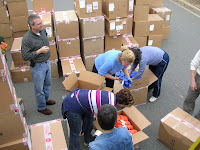Karen Hesse, known for the award-winning free verse book, Out of the Dust, used the same poetic style to write this poignant description of the effects of World War II on the Aleutian Islands. As a fan of historical fiction, I probably wouldn't have considered using poetry to tell the story of the displaced Aleut people. But Hesse, using the voice of the young girl Vera, paints a complete picture of displacement, suffering, and homelessness with sparse language and beautiful imagery.
Her poems speak for themselves:
"Leveling the World of the Aleut"
We hear the white people at the Institute talk. They say
whenever the fog clears over Attu and Kiska,
American fighter planes race out to the very end of the
Aleutians, releasing their bombs on the Japanese
intruders.
I tremble beside Eva, imagining American bombs dropping
like deadly seeds on our emerald earth.
"Oh, Eva," I say, "the bombs are taking root in our place."
"The Value of an Aleut"
Pari and I want to go out and gather the dead grass,
To light a cooking fire outside the tent.
This is the Aleut way. On the chain there are no trees,
Driftwood is scarce:
We make fires from bundles of dry grass.
The man from Indian Affairs
Stitches his net around us:
Aleuts go nowhere without permission, he says.
Aleuts go nowhere.
And we submit.
We stay in a bundle at the Institute.
But our dreams are ravens
Flying west over Shoemaker Bay.
Aleutian Sparrow would be a great supplement for upper elementary and middle school students who are studying the Pacific Theater of Operations in World War II or the Aleutian Islands. This would be an opportunity for Social Studies teachers, who want to integrate literacy practices into their classrooms, to point out Hesse's use of figurative language. The disconcerting image of bombs planting seeds in the first poem, and the metaphors of bundles and nets in the second, are examples of topics that could promote discussion and prompt poetry writing in the history classroom. Recommended for ages 10-14, this book is also available through Listening Library. Although I enjoyed listening to it, students who are studying Hesse's poetic devices should read the hard copy. (Simon & Schuster Children's Books, 2003)
Technorati Tags:Aleutian Sparrow, Aluets, Pacific Theater of Operations, Karen Hesse, Aleutian Islands, writing across the curriculum





